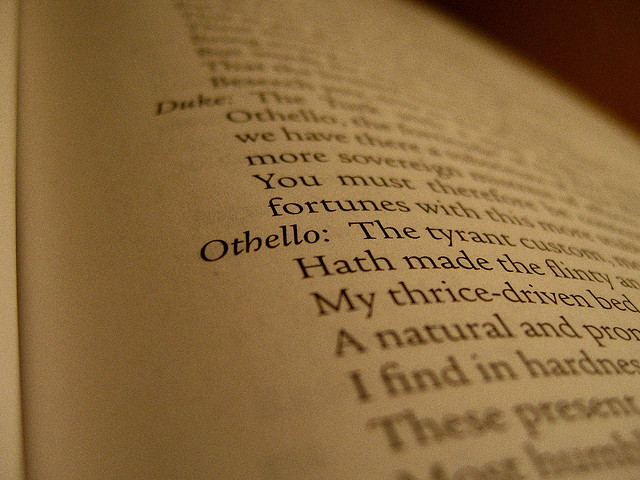Shakespeare's Venice
Professor Carol Rutter, Department of English and Comparative Literary Studies
Published December 2011

For any Elizabethan likely-lad well-heeled enough to afford a European Grand Tour or well-connected enough to secure a passport to travel, Venice was a dream destination.
The city had both a grave and glamorous reputation. It was a republic, and so allowed any English student or observer of political systems an opportunity to study a government completely different from his own experience of monarchy – the absolute rule of a Tudor queen. It had earned the epithet ‘Venice the Wise’, and part of its political wisdom resided in its dedication to peace, signalled in La Serenissima’s personification as a virgin. But it was also known as ‘Venice the Just’ for its reputation for the administration of severe but impartial laws (even to foreigners and lower classes) that were legislated by the republic itself, not derived from civil (that is, Roman) law. And it was called ‘Venice the Rich’ for the spectacular wealth amassed there as a result of its geographic position, wealth on display in architecture and art as well as in the marketplaces and bazaars.
Venice was the commercial cross-point between east and west, and as the city recorder wrote, ‘the most precious merchandise’ of every ‘city famous for merchandising in the Levant’ passed through Venice. This economic power was a magnet for foreign traders, making Venice a visibly cosmopolitan city where, wrote a traveller, ‘if you are curious to see men from all parts of the world, each dressed in his different mode, go to the Piazza di San Marco or to the Rialto.’ There you would see Greeks, Spaniards, Florentines, Turks. And Englishmen: a head-count in the late 1580s put thirty English students living there; in 1593, there were so many ‘English heretics’ – that is, Protestants – living in Venice that the Pope issued a formal complaint to the (religiously tolerant) Doge.
Most sensationally, though, Venice had a reputation as the città galante. She was ‘brave’ (or brazen). She was the pleasure capital of Europe, offering (as one English visitor wrote) open-armed welcome ‘to strangers’ and ‘infinite superfluities of all pleasure and delights’. One of its pleasurable delights was sex. It has been estimated that 10% of the city’s population in 1600 traded openly as courtesans – meretrici de luoghi publici – from doors and windows; richly dressed in Venice lace and imported oriental silks; wearing high platform shoes called chopines; their hair bleached and frizzled; their faces painted white with lead-based cosmetics and lips redded with carmine; their breasts bare. Fascinatingly, and making it tough for the tourist to keep the two categories of women apart, this same high fashion was worn also by the city’s ‘respectable’ women, its Desdemonas and Celias, who were kept, protected, constantly chaperoned, indoors by Venetian fathers and husbands who were notoriously jealous.
What was going on here? Well, the city’s pragmatism was such that, putting marriage at the heart of its social and political institutions, and wanting its girls to be good but knowing its boys would be laddish, a code of civic morality based on mirroring had grown up. That is, the city was able to enforce the honour dynamic that disciplined sex lives in licit domestic culture by tolerating, even encouraging the illicit traffic with ‘meretrici’. Thus, in Venice the sex trade paradoxically protected family values. The city’s testosterone-fuelled adolescents, not yet old enough for marriage, were diverted from seducing wives and deflowering virgins onto professionals who could handle their energies. So: licit illicitness. Licensed licentiousness. What an eye-opener for the English student abroad!
Philip Sidney, the poet, courtier, and Elizabethan golden boy, visited Venice, aged 18, in 1572. The younger brother of his travelling companion would much later be installed there as ambassador from the Court of King James (1604). Sidney left no record of his encounter; Henry Wotton, scores of letters and despatches, including one shrewd observation about shared geopolitical interests, that the Republic was nearly as anti-Papal as was Protestant England: ‘long neutrality of State’, he wrote, had ‘at length (as it seemeth) almost slipped into a neutrality of religion’. Fynes Moryson documented his journey to Venice in 1593; and Thomas Coryat, in his Crudities (1611). In 1599 Lewis Lewkenor published a translation of Gasparo Contarini’s 1543 De Magistratibus et Republica Venetorum, with a supplement for the tourist, an early modern ‘rough guide’ to the city and its sights. John Florio’s English/Italian dictionary, A World of Words, came out in 1598. That same year, a new edition appeared of Cesare Vecellio’s De gli habiti antichi et moderni di diverse parti del mondo illustrated with sixty woodcuts of contemporary Venetian social types in their proper clothing – senators, lawyers, doctors, the fashionable wife and her look-alike, the courtesan – with, on the facing page, a social commentary on each type. So, for the tourist, a sort of ‘rough guide’ to potential in-the-flesh civic encounters.
Much, then, was known in England of Venice, from myth to eye-witness account to near-photographic representation. What did William Shakespeare, the country boy from Stratford-upon-Avon, know of this dazzling Renaissance capital of culture, commerce, and sleaze? Did he ever visit Venice? Probably not. Fynes Moryson estimated that £50-60 should cover a year’s travels for a ‘private gentleman’; Sidney, needing to make much more of a public splash, spent three times that much. Where would a working man come up with such a bankroll? Annual wages for dyers and mercers, shipwrights and glovers, remember, were fixed by Elizabethan statute at £5 per annum. A playwright was paid £6 per script.
 Most probably, Shakespeare read all of the published accounts from Moryson to Coryat – and more: Giraldo Cinthio’s Venetian tale of inter-racial marriage and a wife-murder which hadn’t yet appeared in English. As a reader he was active and attentive, ranging widely across authors and topics, absorbing and processing his reading, and putting it into his writing. His two great plays set in the Republic, The Merchant of Venice and Othello: The Moor of Venice, are scattered with details giving superficial local colour: ‘news' exchanged ‘upon the Rialto’; a loan in ‘ducats’; a clown called ‘Gobbo’ (after the hunchback ‘Gobbo’ in the Rialto market); an elopement conducted ‘by a knave of common hire, a gondolier’.
Most probably, Shakespeare read all of the published accounts from Moryson to Coryat – and more: Giraldo Cinthio’s Venetian tale of inter-racial marriage and a wife-murder which hadn’t yet appeared in English. As a reader he was active and attentive, ranging widely across authors and topics, absorbing and processing his reading, and putting it into his writing. His two great plays set in the Republic, The Merchant of Venice and Othello: The Moor of Venice, are scattered with details giving superficial local colour: ‘news' exchanged ‘upon the Rialto’; a loan in ‘ducats’; a clown called ‘Gobbo’ (after the hunchback ‘Gobbo’ in the Rialto market); an elopement conducted ‘by a knave of common hire, a gondolier’.
More significantly, however, in each of these plays he got to the Venetian heart of the matter: thinking about ethnic and commercial tensions in the city that had invented the idea of the bank; thinking about family, patriarchy, wrongs done to fathers that have the effect of civic insult; thinking about wrongs done to outsiders and whether the ‘alien’ can get a fair trial. At the black core of Iago’s marriage guidance counsel is some insider knowledge, ‘what everybody knows’ about Venetian women: ‘I know our country disposition well. / In Venice they do let God see the pranks / They dare not show their husbands’. At the anguished core of Shylock’s interrogation – ‘what’s his reason? I am a Jew. Hath not a Jew eyes?’ – are questions about how real the myth of ‘Venice the Just’ is.
In Love’s Labour’s Lost Shakespeare has the pedant Holofernes (perhaps a dig at his own pedantry) sigh, ‘Venetia, Venetia: Chi non ti vede, non ti pretia’: ‘Who sees not Venice cannot esteem it’. John Florio supplies the next line of the proverb: ‘Ma chi ti vede, ben gli costa’: ‘But he that sees it, pays well for it.’ in Merchant and Othello Shakespeare lets us ‘see’ Venice, and counts the cost of what we see.
An overview page is now available where you can download the ebook version of A Venetian Miscellany.
 Carol Rutter is Professor of Shakespeare and Performance Studies. She is a historian of the early modern playhouse, who also studies contemporary Shakespeare performance on both stage and screen. From 2006 to 2011 she was Director of the University’s prestigious CAPITAL (Creativity and Performance in Teaching and Learning) Centre – a partnership with the Royal Shakespeare Company which used theatre and performance skills and experience to enhance student learning, and now forms the core of Warwick’s Institute for Advanced Teaching and Learning.
Carol Rutter is Professor of Shakespeare and Performance Studies. She is a historian of the early modern playhouse, who also studies contemporary Shakespeare performance on both stage and screen. From 2006 to 2011 she was Director of the University’s prestigious CAPITAL (Creativity and Performance in Teaching and Learning) Centre – a partnership with the Royal Shakespeare Company which used theatre and performance skills and experience to enhance student learning, and now forms the core of Warwick’s Institute for Advanced Teaching and Learning.
Images: Oh Venezia! by Jose Maria Cuellar (via Flickr)
Othello by Melissa (via Flickr)
